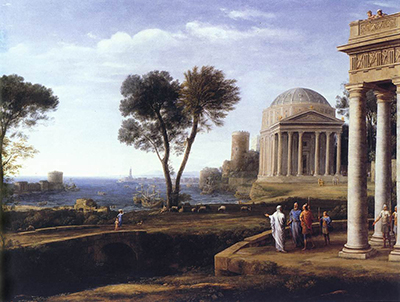This delightful piece from 1672 can be found at the National Gallery in London, UK. Landscape with Aeneas at Delos perfectly captures the essence of Claude Lorrain, featuring all of the characteristics for which he is still famous today.
The composition again includes an assortment of classical architecture running along the right hand side of the painting. There are also small trees dotted about, though with man-made elements taking a prominent role within this piece. Typically he would have the balance tipped more towards nature, but we do still find an expanse of sea in the far distance. Several figures stand and admire the scenery, and we know from Claude's other paintings that these individuals will most likely relate to the title of the piece. The artist was not as confident with figurative art as he was with boats, buildings and landscapes and so they would always be relatively small and somewhat unassuming. Claude practiced his techniques in order to improve his figurative work but could never reach quite the heights that he desired, a situation noted by many critics at the time and in the years since. As the sea rolls out into the distance, Claude also allows the land to encroach somewhat from the sides which helps to build the sense of perspective.
Aeneas at Delos refers to a poem by Virgil. Aeneas was the prince of Troy and he arrives with his father, son and other colleagues to the iland of Delos. It was here that Apollo lived. The King of Delos is also pictured within this scene and most of the figures added by the artist represented specific people. As a general rule, key people would be signified by bright or elaborate clothing that might make them stand out from the others within his paintings and this was a method used by many artists at the time. The artist used mythology and also religious themes in many of his paintings, striking a balance between specialising in landscape art whilst also attracting patrons who might have tastes in other genres.
The National Gallery in London hosts a number of artworks from Claude's career, including A Seaport, A view in Rome, Landscape with a Goatherd and Goats and also Landscape with Cephalus and Procris reunited by Diana. They have over a dozen in total and more of this artist's work can be found elsewhere in the UK, mainly due to a number of British collectors in the 19th century who became particularly keen on his work. Within the National Gallery, these items sit alongside many of the other great names of the past, with the 15th to 19th century particularly well served, including many of the most famous artists from Italy, France, Spain, Germany, the low countries and the UK. It remains one of the most popular tourist attractions in the city, and one of the most visited art galleries anywhere in the world.




